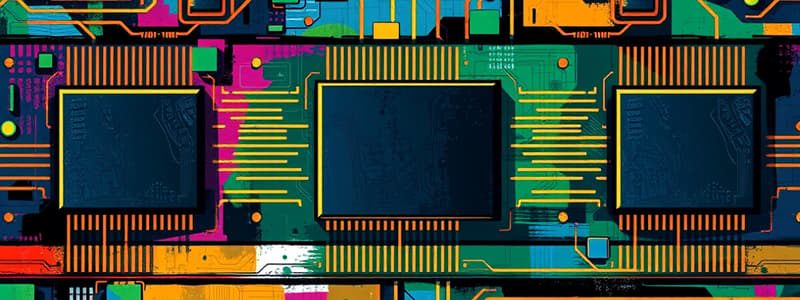Podcast
Questions and Answers
What is an operating system?
What is an operating system?
A set of programs that manages the operations of the computer for the user. It acts as a bridge between the user and the computer's hardware.
Where is the operating system held?
Where is the operating system held?
In permanent storage, such as a hard disk.
How is the operating system started up?
How is the operating system started up?
A small program called the loader is held in ROM, which loads the operating system from storage into RAM.
What are the functions of an operating system?
What are the functions of an operating system?
Name 2 memory management techniques used by the operating system.
Name 2 memory management techniques used by the operating system.
Describe paging.
Describe paging.
What is a page table?
What is a page table?
What is segmentation?
What is segmentation?
What is virtual memory?
What is virtual memory?
What is disk thrashing?
What is disk thrashing?
What is an interrupt?
What is an interrupt?
What happens when the CPU receives an interrupt?
What happens when the CPU receives an interrupt?
Give 3 examples of interrupts in descending order of priority.
Give 3 examples of interrupts in descending order of priority.
Flashcards are hidden until you start studying
Study Notes
Definition of an Operating System
- A collection of programs that manages computer operations for users.
- Acts as a bridge facilitating user interaction with hardware.
Location of the Operating System
- Stored in permanent storage, typically on a hard disk.
Startup Process
- Initiated by a small program known as the loader, located in ROM.
- Loader transfers instructions to load the OS from permanent storage to RAM when the computer powers on.
Functions of an Operating System
- Provides a user interface for interaction.
- Manages memory allocation and usage.
- Executes interrupt service routines to handle events.
- Oversees processor scheduling to maximize efficiency.
- Manages backing store for file storage.
- Controls input and output operations across devices.
Memory Management Techniques
- Paging: Memory divided into fixed-size pages (usually 4KB); allows non-contiguous allocation.
- Segmentation: Divides address space into variable-length segments based on program structure.
Paging Details
- Each process can utilize multiple non-contiguous pages stored in memory.
Page Table
- A mapping system that connects physical memory addresses to logical address spaces for each process.
Segmentation Characteristics
- Allocates memory in segments that vary in length, depending on the program's structure.
- Allows partial loading of programs into memory.
Virtual Memory Functionality
- Extends memory capacity by swapping inactive job pages to disk when RAM is full, allowing secondary storage to function as additional memory.
Disk Thrashing Phenomenon
- Occurs with insufficient memory, leading to excessive swapping of pages between RAM and disk, negatively impacting system performance.
Interrupt Mechanisms
- A signal from software, hardware, or internal clock indicating the CPU needs attention.
- Examples include completion of application programs or requests for OS services.
CPU Response to Interrupts
- Suspends current program execution and disables lower priority interrupts.
- Stores program counter (PC) and register values on the system stack before invoking an Interrupt Service Routine (ISR).
- Upon servicing the interrupt, original register values are restored, allowing the program to continue from where it was interrupted.
Examples of Interrupts in Priority Order
- Power-fail interrupt (highest priority).
- Clock interrupt (medium priority).
- I/O device signal for requesting service or indicating end of operation (lowest priority).
Studying That Suits You
Use AI to generate personalized quizzes and flashcards to suit your learning preferences.




